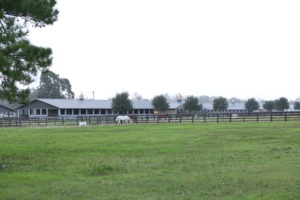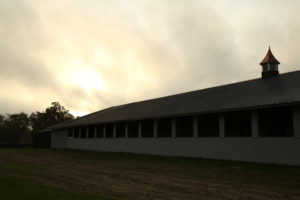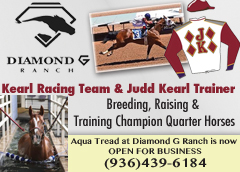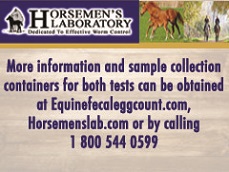Acadiana Equine Clinic, a multi-disciplinary veterinary practice, has been going strong for over 30 years, most of those years at its original location on Gloria Switch Road in Lafayette, Louisiana. As time passed, a number of veterinarians practiced at Acadiana and retired or moved on. Dr. James “Sonny” Corley merged his practice with Acadiana years ago and now counts Drs. Eddie Cramer, Pat Bernard, Justin Jensen, Patrisor Baia, and Mark Buchert as his colleagues in state-of-the-art reproduction services, surgery, orthopedics, lameness treatments, and the care of racehorses.
Acadiana Equine is now located in Opelousas, Louisiana, not far from Evangeline Downs. The clinic is part of Copper Crowne—a gorgeous, 210-acre property dedicated to equine reproduction, health care, training, and rehabilitation. Copper Crowne, so named for the elegant copper cupolas on the brand-new stables, boasts a 6 ½ furlong track, officially sanctioned by the Louisiana Racing Commission for workouts; a large outdoor arena; boarding, foaling, and rehab space for hundreds of horses; barns with living quarters; and superb veterinary facilities. Acadiana Equine’s official title is “Acadiana Equine Clinic at Copper Crowne,” not to be confused with “The Veterinary Clinic at Copper Crowne,” a facility for small animal care just a few small-animal strides away. Dr. Corley’s wife, Dr. Edna Dean Corley, oversees The Veterinary Clinic at Copper Crowne.
Mr. Harold Forman, a prominent builder, developer, and supporter of Thoroughbred racing, envisioned the Copper Crowne concept: a full-service, “cradle-to-grave” facility that caters to every need an equine might require. Mr. Forman had been a friend and client of Dr. Corley for years, and he turned to Dr. Corley for input. Copper Crowne Equestrian Center began to take shape in 2009.
The story of Copper Crowne is a tale of dedicated horsemen deciding to go “first class.” Good friends, old and new, are developing a dream that benefits many others, human and equine.
I talked with Dr. Eddie Cramer, the reproduction specialist, about what Copper Crowne means to him.
You used to work with Dr. Chat Kleinpeter in Baton Rouge.
I started off as more of a general practitioner. I always had a profound interest in reproductive medicine, but I really questioned, honestly, whether the region would support an exclusive reproductive veterinarian.
But the repro services at Kleinpeter/Cramer in Baton Rouge continued to expand, and dramatically outgrew what was available to us. [The facility is leased from the Dixon family.] I love Bill and Mary Lee Dixon and they are very good friends. It’s a beautiful property, but it was never designed to be a breeding farm. The reproductive services within Kleinpeter/Cramer had just outgrown everything we could do there. We looked into developing a facility in the South Baton Rouge area, but the property values were prohibitive.
A large portion of my client base at that point were running quarter horses that were doing embryo transfers. Most of them were in the Acadiana area, but since I was a lot closer than Oklahoma they came to me. So I had a client base in this region already. Kleinpeter and I discussed it for a long time but at the end of the day Chat was not interested in investing in a whole new project 60 miles away at that point in his life. We separated business interests. The “spun out” repro department of Kleinpeter & Cramer became the Louisiana Center for Equine Reproduction, or LACER.
I purchased a tract of land for LACER in Opelousas. After I signed the purchase agreement, the realtor mentioned that somebody had just bought an old horse farm two miles away.
Two days later Dr. Corley called me up and wanted to have lunch because he heard in the wind that a veterinarian just bought some land down the road. We went to lunch and we hardly knew each other. Frankly, there was some concern on both of our sides—you know, “is there a market that you are going after that I’m going after and how competitive are you?” 10 minutes into lunch we figured out that we could be neighbors and friends but we weren’t going to be in competition. LACER and Acadiana Equine at Copper Crowne were happening at the same time. We were friendly but really didn’t do a whole lot of work together until about 2012. And what actually happened was that the first thoroughbred stallion we stood at LACER had a lot of ties back to Dr. Corley and Acadiana. The logic was that LACER didn’t have the capacity to handle that influx of broodmares. Copper Crown would function more as the mare farm and we would haul them over to LACER for breeding and repro. It made a lot of sense. What happened practically is that Dr. Corley and I started working together and getting to know each other…
January 1st of 2015 was the official merger of LACER and Acadiana Equine. We have probably 250 mares in our care.
[Dr. Cramer explains that Harold Forman concentrates on the 150 acres of Copper Crowne that include the training center and track. Dr. Corley purchased Mr. Forman’s interest in the front 50 acres, the location of the original old farm and the new veterinary facilities.]
There is not the same ownership across all of Copper Crowne. At this point Sonny owns half of LACER and I own half of the farm at Copper Crowne.
I don’t see shortcuts here! Everything is first class.
Yes! Breeding and training done right, right here. And LACER has always had that same principle and same core values. Sonny and I see the world the same way. Even though LACER has focused on different breeds and disciplines—particularly running quarter horses—and Copper Crowne has focused on Thoroughbreds, we are open to everything.
We moved the stallions to Copper Crowne and now use the nice, big stallion stalls at LACER as foaling stalls. They tie in well to the office where we have overnight staff. It all fits really well. God is a smart guy! He does a lot when we are not looking.
What seems wonderful about the union of LACER, Acadiana, and Copper Crowne is that it is so amiable.
The only way to be first class is to have people who are really good at what they do. You have to be able to put together a team. You capitalize on everyone’s strengths.
We do really high end reproductive work, which is very near and dear to me, but, for instance, we have the full complement of surgery, particularly emergency surgery. There is a very limited number of practices in the state that offer emergency surgeries. Now we are one of those practices, and especially in this region that’s a big deal. And I think the development of a rehab facility is a huge deal.
I am somewhat familiar with the use of frozen semen in the warmblood breeds. It seems that breeders are having more success these days.
In the last five to seven years, generally speaking, the quality of frozen equine semen has improved dramatically. When you use high quality frozen semen with really well-managed mares, I can’t say I see a significant decrease in fertility. Ten years ago I wouldn’t have said that. A lot of the extender we use to freeze the semen does a much better job of protecting the cells through the preservation process.
Is it hard to time insemination when you use frozen?
In the literature it is claimed that you can be anywhere from 12 hours pre-ovulation to 6 hours post-ovulation. However, in my experience if you are on the edges of that time frame you will have very little success.
What is the time frame for fresh semen?
With fresh we talk about a 48 hour window prior to ovulation, so getting mares pregnant with fresh semen is a lot easier. It’s a lot less time and a lot less work. We have products that can induce ovulation, somewhere between 36 and 48 hours after injection.
When we use frozen, when it is 36 hours post injection we check that mare hourly and then we breed her within an hour post ovulation. If you know you are in that very small time window post ovulation, no more than three or four hours, it’s actually very effective.
Cattle breeders have been using frozen semen successfully much longer than horse breeders.
In general, equine reproduction is very different. The chemicals used to make extenders for bull semen really don’t work that well on the equine sperm cell.
Cattle embryos can be frozen. But with horses we have to use cryoprotectants that basically change the freeze point of the fluid inside the cell. The fluid doesn’t actually freeze but turns into a glass-like state. It’s called vitrification, not freezing.
Cattle embryos are also much smaller than horse embryos. We have to flush mares a bit early to collect smaller embryos. The chemicals are damaging to the cells. If you have too large an embryo, the chemicals will not penetrate the center of the embryo quickly enough before the chemicals start killing the cells on the periphery.
How early in the pregnancy can you flush an embryo?
Six days post ovulation.
That can’t be seen on ultrasound, can it?
Oh, no. The earliest you can consistently find vesicles in a mare’s uterus on an ultrasound is about day 11 or 12.
Every time we do a flush on a donor mare we are hoping there’s an embryo in there. After we collect the fluid, filter it, and look at it, we are either happy or sad.
Conception occurs in the oviduct of the mare. It’s not until day 5 that the embryo enters the uterus. You can’t effectively flush the oviduct with the techniques we commonly use. So we are trying to hit a time frame where the embryo enters the uterus on day 5, and if we wait past day 6 the embryo is too big to vitrify. There are certainly times when you flush the mare on day 6 and you don’t recover an embryo. If she turns up pregnant…well, the embryo was probably still in the oviduct. Not every mare reads the book!
You have to assume a mare is normal, unless she has a history of being abnormal. Some older mares tend to ovulate smaller follicles and tend not to show signs of estrus nearly as long. We have a mare of a client and the biggest her follicle has every grown is 17 or 18 millimeters. She commonly ovulates multiple, very small follicles. She was out of our care for a while, and the stud farm she was at refused to breed her on small follicles. They had her for three heat cycles and never bred her because she ovulated early each time. She came back to the farm I was working at and we settled her back. You have to listen to the individual.
Will a foal carried by a recipient mare be the same quality as a foal carried by its real mother?
Absolutely no genetic material is passed from the recipient mare to the foal. But you get to the question of nurture versus nature. I would suggest that “nurture” starts immediately after conception. The uterine environment of the donor is very different from the uterine environment of the recipient. Unfortunately our ability to assess [uterine environment] is limited. Still, if you look at Thoroughbred produce records, there is certainly a correlation between younger mares and better offspring. I have no numbers to back this up, but logic would certainly support the idea that you would do an embryo a favor by removing from the uterus of an older mare and allowing it to be carried in the healthier uterus of a younger mare.
You mentioned that repro work is very seasonal.
Sure. Around May or June repro slows down substantially and I can help out with other areas of the practice. I do anesthesia sometimes for our surgeon, Dr. Pete Baia. Come January, I won’t be doing much anesthesia!
Thank you, Dr. Cramer!





